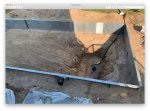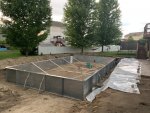If its bank run type you could use it for the deck base. Has to have plenty of stones of various sizes mixed in like road made material that's what packs and holds tight. Against the walls you will never get a good compact down low. Clean gravel is only way to go up to existing sub base
Hi All,
Well now I've had a problem. With things going pretty well, go in the remaining open spot in the walls to dig the deep end yesterday. We are (were?) going for a 8'6" deep end which seems to be standard for pool builders in our area. As luck would have it we hit ground water at about 8 feet though will try to measure exact depth of water table today. Really bummed. We are completely sand down to this point. I'm so surprised because our neighbors 5 houses down had a pool professionally finished a week ago - also to 8'6" without hitting the water. Our sump pump has never run in our house ever (15 years and counting!) We did have a massive rain storm 6 days ago that dumped 6-9 inches in one night in our area. I'm sure this has raised the water table some and our neighbors got there pool in and filled a few days before that rain. I've had the cover pump running in the deep end for 20 hours now and it dropped he water level from about 8 inches to 2 inches high in the deep end while running nearly constant.
So hear are the options I've thought of or read about to this point:
1) try to overdig the bottom by a 12inches or so to 9'6" and throw a foot of gravel in up to water table top and put a drain down there (maybe the main drains i'm not using?) dig a trench back out the shallow end opening and run PVC from the drains to a cheap pool pump to keep the water out during construction. Try to build as normal - though the sandy walls are such a challenge even without this curveball.
2) try to dig a sump well around outside of the concrete collar (perhaps to end up in future landscaping). I have no idea how to do this though with the tools/equipment I have on hand.
2)Keep myself occupied with other projects over the next week or so and see if the water table drops by next week with more hot and hopefully dry weather in store here.
3)Though I have a liner for 8' 6" depth in my garage, call the excavation quits at 8' and shape it appropriately for that depth pool. Install the liner anyway (no main drains) accepting it will be very wrinkled at the bottom. Until the next liner in 10 years or so.
4)Order a new liner for an 8' depth and eat the price of the wasted liner (ugh).
I'm not entirely sure I can do 8' right now without any issue either - still might be an inch or two into current water table as I know I'll confirm this morning with some fresh measurements. Such a bummer and just kind of sick to my stomach to be honest





